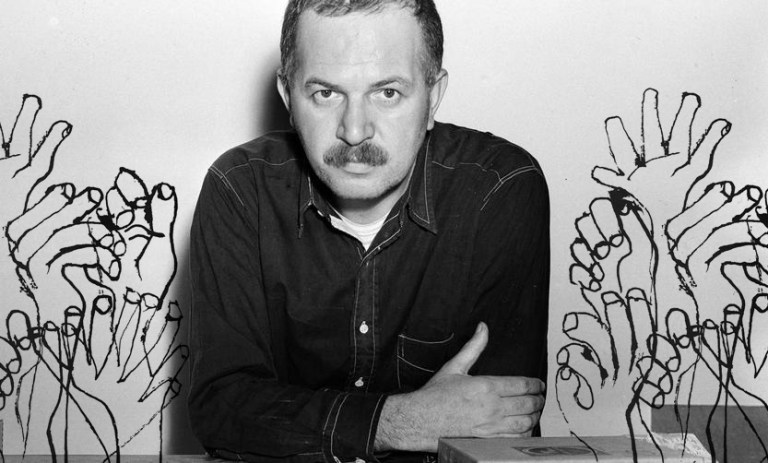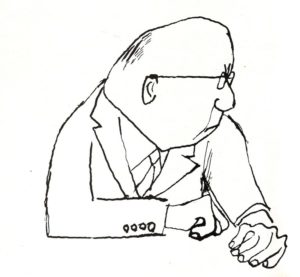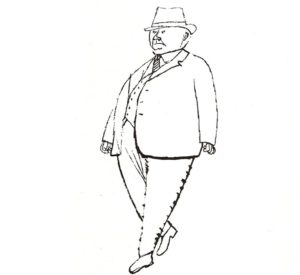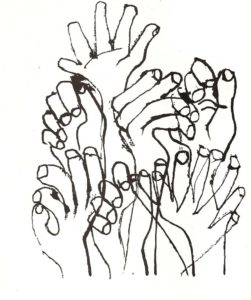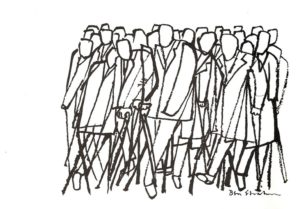On Nonconformity: Artist Ben Shahn’s Spirited Defense of Nonconformists as Society’s Engine of Growth and Greatness
INSPIRATIONAL, 28 Nov 2016
Maria Popova | Brain Pickings – TRANSCEND Media Service
“Without the nonconformist, any society of whatever degree of perfection must fall into decay.”
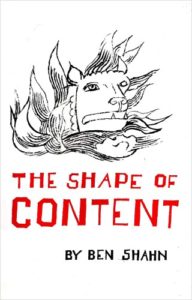 “Society,” Emerson wrote in his timeless treatise on self-reliance and what it really means to be a nonconformist, “is a joint-stock company, in which the members agree, for the better securing of his bread to each shareholder, to surrender the liberty and culture of the eater.” In such a groupthink society, Emerson cautioned, conformity is the most prized virtue, but whoever wishes to be a true person “must be a nonconformist.”
“Society,” Emerson wrote in his timeless treatise on self-reliance and what it really means to be a nonconformist, “is a joint-stock company, in which the members agree, for the better securing of his bread to each shareholder, to surrender the liberty and culture of the eater.” In such a groupthink society, Emerson cautioned, conformity is the most prized virtue, but whoever wishes to be a true person “must be a nonconformist.”
“Life would be dull indeed without experimenters and courageous breakers-with-tradition,” wrote Marie Bullock, the courageous founder of the Academy of American Poets, a century later when she rose to defend E.E. Cummings from his detractors in 1951 — detractors who had attacked the Academy for awarding him their annual fellowship and accused Cummings, now one of the most beloved and influential artists of the past century, for being an “arch-poseur and pretender” and a “disintegrator of language” who had dared to break with tradition, invent new creative forms, and, in sum, be a nonconformist.
Five years later, the great artist Ben Shahn (September 12, 1898–March 14, 1969) made what remains the most elegant case for the transformative power and sheer cultural necessity of nonconformity in one of his six lectures for Harvard’s Charles Edward Norton Lectures, eventually published with original illustrations by Shahn as The Shape of Content (public library).
In the fourth of the six lectures, titled “On Nonconformity,” Shahn writes:
The artist is likely to be looked upon with some uneasiness by the more conservative members of society. He seems a little unpredictable. Who knows but that he may arrive for dinner in a red shirt… appear unexpectedly bearded… offer, freely, unsolicited advice… or even ship off one of his ears to some unwilling recipient? However glorious the history of art, the history of artists is quite a different matter. And in any well-ordered household the very thought that one of the young men may turn out to be an artist can be a cause for general alarm. It may be a point of great pride to have a Van Gogh on the living room wall, but the prospect of having Van Gogh himself in the living room would put a good many devoted art lovers to rout.
Shahn illustrates the value of nonconformity as a catalyst of cultural evolution with the story of the tumult that took place in France when officials proposed that one of the pavilions of the prestigious 1925 Paris Exhibition be set up in the space belonging to the Society of Independent Artists — the collective of nonconformists whose annual exhibitions had been setting the tone for modern art since their formation in 1884. It was suggested that these innovators had done their job and there was no further need for their tradition-upending sensibility, so they should relinquish their space to the traditional art establishment.
An art critic appalled by the backward proposition responded with twenty-five reasons why the Independents should keep their space and hold their annual exhibition. The reasons he listed were only names — the names of the most recent winners of the Prix de Rome, the venerated French art award that had been conferred upon promising talents in traditional art since 1663. All but one of those names were by then completely unknown. The critic juxtaposed those with the names of twenty-five artists who had presented at the Independents’ exhibition — artists who, as Shahn points out, “could not by any stretch of the imagination have won such an award [as the Prix de Rome].” Among those were Picasso, Van Gogh, Gauguin, Matisse, and Cézanne.
Shahn considers the allegorical moral of the incident:
By fulfilling current standards drawn out of past art, the applicants [to the Prix de Rome] had won the approval of officials whose standards also were based upon past art, and who could hardly be expected to have visions of the future. But it is always in the future that the course of art lies, and so all the guesses of the officials were wrong guesses.
The very quality that prevents artists like the Independents from being lauded by the traditional establishment, Shahn argues, is the same quality that makes them capable of shaping the future, unencumbered by the past. He writes:
All art is based upon nonconformity [and] every great historical change has been based upon nonconformity, has been bought either with the blood or with the reputation of nonconformists. Without nonconformity we should have had no Bill of Rights or Magna Charta, no public education system, no nation upon this continent, no continent, no science at all, no philosophy, and considerably fewer religions. All that is pretty obvious.
But it seems to be less obvious somehow that to create anything at all in any field, and especially anything of outstanding worth, requires nonconformity, or a want of satisfaction with things as they are. The creative person — the nonconformist — may be in profound disagreement with the present way of things, or he may simply wish to add his views, to render a personal account of matters.
Shahn notes that while creative nonconformity is sometimes immediately recognizable as intransigence and deliberate rebellion, it isn’t always predicated on sudden and total upending of tradition — it often happens that a series of artists each contribute systematic small steps that eventually add up to an unexpected cultural leap. (Steven Johnson has termed this type of incremental innovation in science “the hummingbird effect.”) And yet all nonconformity — whether it operates on a small or large scale, whether it occurs in an instant or over time — requires a dissatisfaction with the status quo or, at the very least, a disinterest in its dicta. In a sentiment that James Baldwin would come to echo just a few years later in his unforgettable assertion that “the war of an artist with his society is a lover’s war,” Shahn writes:
The artist occupies a unique position vis-à-vis the society in which he lives. However dependent upon it he may be for his livelihood, he is still somewhat removed from its immediate struggles for social status or for economic supremacy. He has no really vested interest in the status quo.
The only vested interest — or one might say, professional concern — which he does have in the present way of things rests in his ability to observe them, to assimilate the multifarious details of reality, to form some intelligent opinion about the society or at least an opinion consistent with his temperament.
That being the case, he must maintain an attitude at once detached and deeply involved. Detached, in that he must view all things with an outer and abstracting eye. Shapes rest against shapes, colors augment colors, and modify and relate and mingle mutually. Contrasts in life move constantly across the field of vision — tensions between the grotesque and the sad, between the contemptible and the much-loved; tensions of such special character as to be almost imperceptible; dramatic, emotional situations within the most banal settings. Only the detached eye is able to perceive these properties and qualities of things.
Within such contrasts and juxtapositions lies the very essence of what life is today, or any day. Whoever would know his day or would capture its essential character must maintain such a degree of detachment.
And yet where the artist differs from the scientist, Shahn argues, is in the necessity for feeling things in addition to merely perceiving them. Unlike the scientist, who may exhibit what Einstein called “a passion for comprehension” but goes about pursuing that passion with the cool tools of reason, the artist operates from an intuitive place of deep feeling. Echoing Anaïs Nin’s assertion that emotional excess is essential for creativity, Shahn writes:
[The artist] must never fail to be involved in the pleasures and the desperations of mankind, for in them lies the very source of feeling upon which the work of art is registered. Feeling, being always specific and never generalized, must have its own vocabulary of things experienced and felt.
It is because of these parallel habits of detachment and of emotional involvement that artists so often become critics of society and so often become partisans in its burning causes. And also it is why they are so likely to be nonconformists in their personal lives.
More than a century after Kierkegaard contemplated the power of the minority and why we conform, Shahn points out the paradox of nonconformity, which has only grown more pronounced in the decades since:
It is an amusing contradiction of our time that we do applaud a sort of copy-book nonconformity. Everyone laments the increase in conformity; everyone knows that too much conformity is bad for art and literature and politics, and that it may deal the death-blow to National Greatness. The deadening effects of over-conformity are well understood. Yet, when it comes to the matter of just what kind of nonconformity shall be encouraged, liberality of view recedes. There seems to be no exact place where nonconformity can be fitted in.
[…]
Without the person of outspoken opinion, however, without the critic, without the visionary, without the nonconformist, any society of whatever degree of perfection must fall into decay. Its habits (let us say its virtues) will inevitably become entrenched and tyrannical; its controls will become inaccessible to the ordinary citizen.
[…]
Nonconformity is the basic pre-condition of art, as it is the pre-condition of good thinking and therefore of growth and greatness in a people. The degree of nonconformity present — and tolerated — in a society must be looked upon as a symptom of its state of health.
Shahn considers the primary species of conformity:
There is always an impressive number of artists who are overwhelmed by the nearest outstanding figure. They adopt his point of view and mannerisms and become a school; that is one kind of art conformity.
Another kind of conformity is derived from the wholly venal business of catering to a popular market. Still another results from trends and the yearning of artists — an almost irresistible yearning — to be in the forefront of things.
Writing half a century before the filter bubble of the social web, that ultimate generator of groupthink, Shahn adds:
All these kinds of conformity are inevitable and to be expected. But there has grown around us a vastly increased conformity. One could say “conformism” here; for this is conformity by doctrine and by tribunal.
Shahn ends with a timeless and poignantly illustrative parable of the difference in motives driving the various conformists and the nonconformist — a parable a version of which the poet Sarah Kay, a true nonconformist of our time, likes to tell. Shahn writes:
I remember a story that my father used to tell of a traveler in thirteenth-century France who met three men wheeling wheelbarrows. He asked in what work they were engaged and he received from them the following three answers: the first said, “I toil from sunup to sundown and all I receive for my pain is a few francs a day.” The second said, “I am glad enough to wheel this wheelbarrow for I have been out of work for many months and I have a family to support. The third said, “I am building Chartres Cathedral.”
I always feel that the committees and the tribunals and the civic groups and their auxiliaries harbor no misgivings about the men who wheel their wheelbarrows for however many francs a day; the object of their suspicions seems, inevitably, to be the man who is building Chartres Cathedral.
Complement Shahn’s thoroughly invigorating The Shape of Content with James Baldwin on the artist’s struggle for integrity and Teresita Fernández on what it takes to be an artist, then revisit Albert Camus on what it means to be a rebel and the vintage satirical gem How to Be a Nonconformist.
____________________________________
 Brain Pickings is the brain child of Maria Popova, an interestingness hunter-gatherer and curious mind at large obsessed with combinatorial creativity who also writes for Wired UK and The Atlantic, among others, and is an MIT Futures of Entertainment Fellow. She has gotten occasional help from a handful of guest contributors.
Brain Pickings is the brain child of Maria Popova, an interestingness hunter-gatherer and curious mind at large obsessed with combinatorial creativity who also writes for Wired UK and The Atlantic, among others, and is an MIT Futures of Entertainment Fellow. She has gotten occasional help from a handful of guest contributors.
Go to Original – brainpickings.org
DISCLAIMER: The statements, views and opinions expressed in pieces republished here are solely those of the authors and do not necessarily represent those of TMS. In accordance with title 17 U.S.C. section 107, this material is distributed without profit to those who have expressed a prior interest in receiving the included information for research and educational purposes. TMS has no affiliation whatsoever with the originator of this article nor is TMS endorsed or sponsored by the originator. “GO TO ORIGINAL” links are provided as a convenience to our readers and allow for verification of authenticity. However, as originating pages are often updated by their originating host sites, the versions posted may not match the versions our readers view when clicking the “GO TO ORIGINAL” links. This site contains copyrighted material the use of which has not always been specifically authorized by the copyright owner. We are making such material available in our efforts to advance understanding of environmental, political, human rights, economic, democracy, scientific, and social justice issues, etc. We believe this constitutes a ‘fair use’ of any such copyrighted material as provided for in section 107 of the US Copyright Law. In accordance with Title 17 U.S.C. Section 107, the material on this site is distributed without profit to those who have expressed a prior interest in receiving the included information for research and educational purposes. For more information go to: http://www.law.cornell.edu/uscode/17/107.shtml. If you wish to use copyrighted material from this site for purposes of your own that go beyond ‘fair use’, you must obtain permission from the copyright owner.
